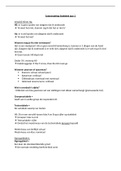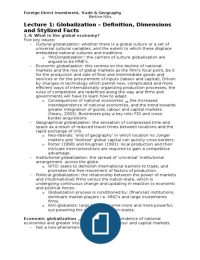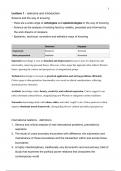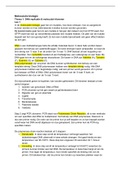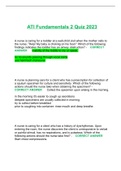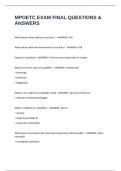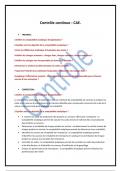Global Banking: Summary of all synchronous lectures
Synchronous Lecture 1: 24 october 2022
Risks of Financial Intermediaries
- The rationale behind the existence of FI’s implies that they face certain risks.
- Risk measurement is a quantitative subject
v Interest rate risk
Ø Mismatch in maturities between assets and liabilities. Two types
§ Refinancing risk: when assets have longer maturities then liabilities.
• If depositors come to pick up money, there is none.
• Or increase of depositor rates, such that assets are not lucrative anymore
§ Reinvestment risk, when assets have shorter maturities then liabilities
• After assets’ maturity, there is no interest rate income, but there remains a
liability of paying interest to depositors (liabilities)
• Or: decrease in rates on assets, such that banks’ income drops and thus
liabilities cannot paid anymore.
Ø KEY ISSUE: matching maturities of assets and liabilities is inconsistent with the asset
transformation function.
§ Borrowers want long-term loans
§ Depositors want short-term liquid funds
v Credit risk
Ø Risk that promised cash flows on financial claims hold by FI’s are not paid in full (e.g.
default on mortgages).
§ Firm specific CR
• Associated with specific projects of the firm
¨ Project can default
§ Systematic: macro-economic risk
• Recession can cause a lot of defaults
Ø How to deal with CR?
§ Screening before underwriting
• less adverse selection
§ Monitoring after underwriting
• reduce moral hazard
§ Diversification
• Negatively correlated returns over the portfolio (different firms)
§ Pricing
• higher credit risk can have higher price
v Off-balance-sheet risk
Ø Striking growth of off-balance sheets activities
§ Letters of credits (credit cards)
§ Loan commitments
§ Derivative positions
Ø However, these activities might affect the balance sheet in the future.
§ This might create considerable risk (like we saw in 2008 crisis).
,Global Banking: Summary of all synchronous lectures
v Liquidity risk
Ø Risk of being forced to sell assets in a very short period of time
§ In case if a sudden increase in withdrawals occur
• e.g. cash from ATM’s
§ This can generate a bank run
• Could turn liquidity problem into a solvency problem.
v Insolvency risk
Ø Risk of insufficient capital to offset sudden decline in value of assets relative to
liabilities.
v Market risk
Ø Risk of losses from actively trading assets and derivatives
§ Trading risk is present whenever a FI takes an open (unhedged) long or short
position in securities and its price takes unexpected directions.
v Fintech risk
Ø Risk of technology enabled innovations in financial services that result in new
business models
§ Might effect current provision of financial services in a disruptive way
§ Indicates a variety of financial innovations by both existing FI’s and more
importantly, new entrants. (Existing FI’s cannot stay out of innovating)
v Other risks
Ø Foreign exchange risk
§ Exchange rate changes affect value of assets/liabilities the FI’s might hold.
Ø Sovereign risk
§ Foreign governments might impose trading restrictions on repayments or even
governments itself might not repay (‘default’). Lacks the resource via a
independent court system, so this risk is almost impossible to hedge away.
Ø Technology and Operational risk
§ Technology investments might fail to produce the expected cost savings.
§ Operational risk: existing technology or support system could malfunction or
entirely break down. This also considers employee frauds and error.
NOTE: We don’t consider other risks in this course.
Synchronous Lecture 2: 25 october 2022
Empirical Evidence:
Degryse, Kim and Ongena: Why do Financial Intermediary exist?
v Theory on financial intermediation: banks may learn a substantial amount of information
on firms because of the closely monitoring repayment of its loan.
, Global Banking: Summary of all synchronous lectures
Ø Question: How would we test monitoring theory?
§ Measure stock price reaction of firms that gets new loan agreement (James,
1987).
Ø Event study methodology is employed to evaluate the value produced by bank-firms
agreements.
Ø Findings:
§ Bank loan announcements are associated with positive stock price reactions
equal to 193 basis points in a 2-day window.
§ Furthermore, announcements of privately placed and public issue of debt have
zero or negative stock price reaction of the certain firm.
Ø Conclude:
§ Supports the idea that a bank loan provides possible abilities for firms to generate
positive cash flows.
An alternative way to assess value of firm-bank agreements is to evaluate the banks’
reaction:
Ø Question: Does a bank failure leads to firm failure?
§ Insolvency of banks affects stock price of firms with an ongoing lending
relationship (Slovin, Sushka and Polonchek, 1993).
• Around the insolvency announcement, those firms had a negative average
abnormal 2-day return of 420 basis points.
Ø Findings:
§ Evidence is mixed here. And much evidence comes from countries which have
faced bank crises.
Ongena, Smith and Michalsen (2003) analyzes event studies near collapse
of Norwegian banking system.
Ø Finding:
§ Banks are seriously affected by distress, firms aren’t that much. Result differs
from Japan firms.
Ø Hypothesis:
§ Corporate governance. Norwegian firms are weakly controlled by banks. In Japan
bank’s have larger impact.
• Several examples:
• Japan banks have lots of voting shares in firms
• Bank sits on common firm boards
• Weak minority shareholder protection etc
Ø How to test hypothesis:
Synchronous Lecture 1: 24 october 2022
Risks of Financial Intermediaries
- The rationale behind the existence of FI’s implies that they face certain risks.
- Risk measurement is a quantitative subject
v Interest rate risk
Ø Mismatch in maturities between assets and liabilities. Two types
§ Refinancing risk: when assets have longer maturities then liabilities.
• If depositors come to pick up money, there is none.
• Or increase of depositor rates, such that assets are not lucrative anymore
§ Reinvestment risk, when assets have shorter maturities then liabilities
• After assets’ maturity, there is no interest rate income, but there remains a
liability of paying interest to depositors (liabilities)
• Or: decrease in rates on assets, such that banks’ income drops and thus
liabilities cannot paid anymore.
Ø KEY ISSUE: matching maturities of assets and liabilities is inconsistent with the asset
transformation function.
§ Borrowers want long-term loans
§ Depositors want short-term liquid funds
v Credit risk
Ø Risk that promised cash flows on financial claims hold by FI’s are not paid in full (e.g.
default on mortgages).
§ Firm specific CR
• Associated with specific projects of the firm
¨ Project can default
§ Systematic: macro-economic risk
• Recession can cause a lot of defaults
Ø How to deal with CR?
§ Screening before underwriting
• less adverse selection
§ Monitoring after underwriting
• reduce moral hazard
§ Diversification
• Negatively correlated returns over the portfolio (different firms)
§ Pricing
• higher credit risk can have higher price
v Off-balance-sheet risk
Ø Striking growth of off-balance sheets activities
§ Letters of credits (credit cards)
§ Loan commitments
§ Derivative positions
Ø However, these activities might affect the balance sheet in the future.
§ This might create considerable risk (like we saw in 2008 crisis).
,Global Banking: Summary of all synchronous lectures
v Liquidity risk
Ø Risk of being forced to sell assets in a very short period of time
§ In case if a sudden increase in withdrawals occur
• e.g. cash from ATM’s
§ This can generate a bank run
• Could turn liquidity problem into a solvency problem.
v Insolvency risk
Ø Risk of insufficient capital to offset sudden decline in value of assets relative to
liabilities.
v Market risk
Ø Risk of losses from actively trading assets and derivatives
§ Trading risk is present whenever a FI takes an open (unhedged) long or short
position in securities and its price takes unexpected directions.
v Fintech risk
Ø Risk of technology enabled innovations in financial services that result in new
business models
§ Might effect current provision of financial services in a disruptive way
§ Indicates a variety of financial innovations by both existing FI’s and more
importantly, new entrants. (Existing FI’s cannot stay out of innovating)
v Other risks
Ø Foreign exchange risk
§ Exchange rate changes affect value of assets/liabilities the FI’s might hold.
Ø Sovereign risk
§ Foreign governments might impose trading restrictions on repayments or even
governments itself might not repay (‘default’). Lacks the resource via a
independent court system, so this risk is almost impossible to hedge away.
Ø Technology and Operational risk
§ Technology investments might fail to produce the expected cost savings.
§ Operational risk: existing technology or support system could malfunction or
entirely break down. This also considers employee frauds and error.
NOTE: We don’t consider other risks in this course.
Synchronous Lecture 2: 25 october 2022
Empirical Evidence:
Degryse, Kim and Ongena: Why do Financial Intermediary exist?
v Theory on financial intermediation: banks may learn a substantial amount of information
on firms because of the closely monitoring repayment of its loan.
, Global Banking: Summary of all synchronous lectures
Ø Question: How would we test monitoring theory?
§ Measure stock price reaction of firms that gets new loan agreement (James,
1987).
Ø Event study methodology is employed to evaluate the value produced by bank-firms
agreements.
Ø Findings:
§ Bank loan announcements are associated with positive stock price reactions
equal to 193 basis points in a 2-day window.
§ Furthermore, announcements of privately placed and public issue of debt have
zero or negative stock price reaction of the certain firm.
Ø Conclude:
§ Supports the idea that a bank loan provides possible abilities for firms to generate
positive cash flows.
An alternative way to assess value of firm-bank agreements is to evaluate the banks’
reaction:
Ø Question: Does a bank failure leads to firm failure?
§ Insolvency of banks affects stock price of firms with an ongoing lending
relationship (Slovin, Sushka and Polonchek, 1993).
• Around the insolvency announcement, those firms had a negative average
abnormal 2-day return of 420 basis points.
Ø Findings:
§ Evidence is mixed here. And much evidence comes from countries which have
faced bank crises.
Ongena, Smith and Michalsen (2003) analyzes event studies near collapse
of Norwegian banking system.
Ø Finding:
§ Banks are seriously affected by distress, firms aren’t that much. Result differs
from Japan firms.
Ø Hypothesis:
§ Corporate governance. Norwegian firms are weakly controlled by banks. In Japan
bank’s have larger impact.
• Several examples:
• Japan banks have lots of voting shares in firms
• Bank sits on common firm boards
• Weak minority shareholder protection etc
Ø How to test hypothesis:

